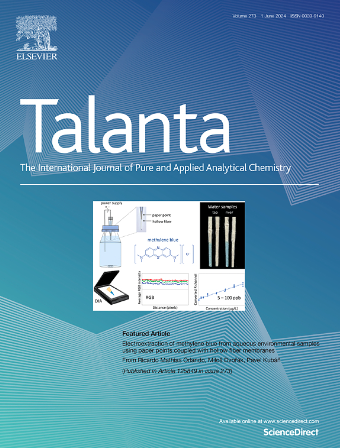商用试剂为基础的六模式传感器:一步检测碘离子没有酶或纳米材料
IF 5.6
1区 化学
Q1 CHEMISTRY, ANALYTICAL
引用次数: 0
摘要
多信号传感器在即时检测方面具有巨大的潜力,但由于依赖复杂的纳米材料合成或脆弱的酶系统,它们的广泛采用受到阻碍。在此,我们提出了一种“六合一”多模式传感器,用于快速检测碘离子(I−),仅利用三种市买试剂:氯铂酸(H2PtCl6),十六烷基三甲基溴化铵(CTAB)和3,3 ',5,5 ' -四甲基联苯胺(TMB)。核心创新点在于靶I -离子触发的动态“开-关-开”氧化:氧化能力强的H2PtCl6直接将TMB氧化成双电子产物(TMB2+)(“On”态)。CTAB与H2PtCl6配合,阻断其表面,完全抑制TMB氧化(“Off”状态)。I−通过竞争配位选择性取代CTAB,部分恢复H2PtCl6的氧化活性,生成单电子产物(TMBox)(“再激活”状态)。值得注意的是,TMBox具有六种不同的信号输出,包括视觉和荧光颜色、吸光度、荧光、温度和电流。与传统的单模或双模方法相比,我们的六模方法提高了检测结果的可靠性。这种“魔方”信号实现了双模定性分析和四模定量检测,实现了I -检测的纳米摩尔级检测极限。关键的是,多模式传感器通过一步混合操作,而不需要纳米材料,酶或专门的设备。我们进一步证明了它在检测生物(尿液、血清)、食品(碘盐)和环境(黄河水、自来水)样品中的I -的实用性,回收率为96.3% - 110.0%。统计分析显示重复性好,重复测量的相对标准偏差为3.1%。这项工作重新定义了多模式传感的范例,为环境监测和临床诊断提供了一种具有成本效益的、可现场部署的解决方案。本文章由计算机程序翻译,如有差异,请以英文原文为准。

Commercial reagents-based six-mode sensor: One-step detection of iodide ions without enzymes or nanomaterials
Multi-signal sensors possess immense potential for point-of-care testing, yet their widespread adoption is hindered by reliance on complex nanomaterial synthesis or fragile enzymatic systems. Herein, we propose a “six-in-one” multi-mode sensor for rapid iodide ion (I−) detection, leveraging only three commercially available reagents: chloroplatinic acid (H2PtCl6), hexadecyl trimethylammonium bromide (CTAB), and 3,3′,5,5′-tetramethylbenzidine (TMB). The core innovation lies in a dynamic “on-off-on” oxidation triggered by target I− ions as follows: H2PtCl6 with strong oxidative capacity directly oxidizes TMB to its two-electron product (TMB2+) (“On” State). CTAB coordinates with H2PtCl6 thereby blocking its surface and completely inhibiting TMB oxidation (“Off” State). I− selectively displaces CTAB via competitive coordination, partially restoring H2PtCl6's oxidation activity to generate the one-electron product (TMBox) (“Reactivation” State). Remarkably, the resulting TMBox exhibits six distinct signal outputs including visual and fluorescent color, absorbance, fluorescence, temperature, and electrical current. Compared to conventional single- or dual-mode methods, our six-mode approach improves reliability of detection results. This “magic cube” signals enables dual-mode qualitative analysis and four-mode quantitative detection, achieving a nanomolar-level detection limit for I− detection. Critically, multi-mode sensor operates via one-step mixing without requiring nanomaterials, enzymes, or specialized equipment. We further demonstrate its utility in detecting I− in biological (urine, serum), food (iodized salt) and environmental (Yellow River water, tap water) samples with recovery rates of 96.3 %–110.0 %. Statistical analysis demonstrated excellent reproducibility with relative standard deviations <3.1 % across repeated measurements. This work redefines the paradigm of multi-mode sensing, offering a cost-effective, field-deployable solution for environmental monitoring and clinical diagnostics.
求助全文
通过发布文献求助,成功后即可免费获取论文全文。
去求助
来源期刊

Talanta
化学-分析化学
CiteScore
12.30
自引率
4.90%
发文量
861
审稿时长
29 days
期刊介绍:
Talanta provides a forum for the publication of original research papers, short communications, and critical reviews in all branches of pure and applied analytical chemistry. Papers are evaluated based on established guidelines, including the fundamental nature of the study, scientific novelty, substantial improvement or advantage over existing technology or methods, and demonstrated analytical applicability. Original research papers on fundamental studies, and on novel sensor and instrumentation developments, are encouraged. Novel or improved applications in areas such as clinical and biological chemistry, environmental analysis, geochemistry, materials science and engineering, and analytical platforms for omics development are welcome.
Analytical performance of methods should be determined, including interference and matrix effects, and methods should be validated by comparison with a standard method, or analysis of a certified reference material. Simple spiking recoveries may not be sufficient. The developed method should especially comprise information on selectivity, sensitivity, detection limits, accuracy, and reliability. However, applying official validation or robustness studies to a routine method or technique does not necessarily constitute novelty. Proper statistical treatment of the data should be provided. Relevant literature should be cited, including related publications by the authors, and authors should discuss how their proposed methodology compares with previously reported methods.
 求助内容:
求助内容: 应助结果提醒方式:
应助结果提醒方式:


